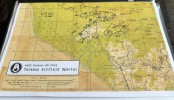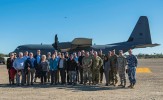Search
Using the filters to the left, click your selection, it will become bold and filter the results, click it again to remove that filter.
Keogh Chair and Allis Chalmers Professor of Political Science at Marquette University Chief of Army Symposium 2025, Australian Parliament House, 26 August 2025 Good morning, everyone. Thank you, Brigadier Campbell, for that kind introduction. I would also like to thank Lieutenant General Stuart for inviting me to be here today, and his team, who have welcomed me so graciously. I am delighted to visit your beautiful country. It is my great honor today to speak to you on the relationship between army and …
Lieutenant Colonel Dr Adam J Hepworth, PhD is Director of the Army RICO. In this role, Adam leads the advancement of emerging technology, including robotics, autonomous systems, AI and autonomy for the Australian Army. Adam holds a Bachelor of Science in Mathematics from the University of New South Wales, a Master of Logistics and Supply Chain Management from the University of South Australia, a Graduate Diploma in Scientific Computation and a Master of Science in Operations Research from the United States …

Callum Hamilton is AI Policy Lead of the Australian Army Robotics and Autonomous Systems Implementation Coordination Office (RICO) within Future Land Warfare Branch. In this role, Callum supports the Australian Army’s responsible application and use of AI and autonomous systems in the land domain. Callum holds a Bachelor of Laws (Honours) and Bachelor of International Relations from Bond University and is currently completing a Graduate Diploma of Legal Practice at the College of Law. … Callum …
Dr Carl Rhodes is the founder of Robust Policy and a senior fellow with the National Institute for Deterrence Studies . He hosts the Deterrence Down Under podcast and previously served for 25 years with RAND Corporation. … Carl Rhodes …
Australian Operations to Degrade the Islamic State—2014–2024 Executive Summary Beginning in 2014, the Australian Defence Force (ADF) was committed to Operation Okra in the Middle East, with the aim of degrading the Islamic State, ISIS, or Daesh. This objective was ultimately achieved in 2018, although ongoing operations monitoring the threat have since continued. It has now been a decade since the commencement of this intervention, which the ADF formally concluded in December 2024. The Chief of Defence …
Lieutenant Colonel Aaron P Jackson PhD is Senior Research Officer at the Australian Army Research Centre. A SERCAT 5 (i.e., part time) Infantry officer, he is a former Commanding Officer of 10th/27th Battalion, The Royal South Australia Regiment. He has deployed on Operation Okra (Iraq), Operation Astute (Timor Leste), Operation Resolute (Australian border security), and Operation COVID-19 Assist (domestic emergency response). In his civilian employment, Dr Jackson is Senior Lecturer in War Studies at …
The Oboe landings – well planned, resourced and executed – were, and are, rightly considered the acme of amphibious operations. Dayton McCarthy Introduction to The Oboe Landings 1945 Australian Army History Unit, Campaign Series 32 “G’Day Sir, I’m looking for your support to attend a staff ride.” These were my hopeful words to my boss shortly after learning of an opportunity to travel to Borneo to study a series of 1945 amphibious operations. A staff ride wasn’t something I had previously heard of, and I …

Lieutenant Chris Wooding is an Australian Army officer. He has previously published in blogs such as Grounded Curiosity , The Forge and the Australian Strategic Policy Institute’s The Strategist . LT Wooding also has a chapter published in Australian Perspectives on Air and Space Power: Past, Present, Future (2023). … Chris …
Australian Army Staff Rides A key part of the AARC’s charter is to enhance the professionalism, leadership and ethical awareness of Australian soldiers and officers. To fulfil its role, one of its directed tasks is the conduct of staff rides and battlefield study tours. These activities involve the deep study of a battle or campaign, the key component of which is an extensive field phase that allows an examination of the actual ground where the fighting occurred. In order to elicit critical discussion …


